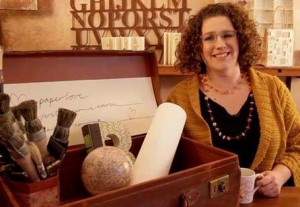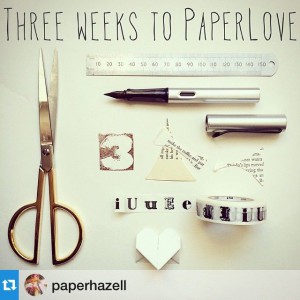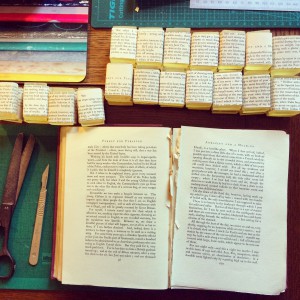I interned for Rachel Hazell, a bookbinder and paper artist based in Edinburgh. Rachel has been a self-employed book artist since 1998 when she founded her first company, Hazell Designs Books. She is passionate about books but more than anything else she’s passionate about paper itself. Her strong drive to share her passion for paper with others has taken her around the world: she has taught bookbinding and book art workshops in Scotland, Paris, Venice, California, and as far afield as Antarctica.
My work as an intern primarily involved marketing and publicity for PaperLove, Rachel’s online paper art course. The PaperLove e-course is five-week class that explores a range of paper art and paper craft. It is advertised as a course “Developed to enable everyone, no matter where they live, to work with Rachel to develop their creativity through the medium of paper”. Each week of the course is devoted to a specific theme or craft. The themes for each of the five weeks are: paper, collage, word, book, and mail. You can learn more about the course here.
The PaperLove e-course runs two times each year. As soon as my internship began in January I started
working to promote the March run of the course. Working with a limited marketing budget Rachel and I focused on using social media and electronic word-of-mouth marketing as a way of reaching potential “PaperLovers”. We used Instagram to host giveaways and to advertise the course. (The Society of Young Publishers recently did a feature on Rachel’s delightful Instagram account here.) On Facebook we used the Paperphilia page to share free DIY tutorials as a way of giving potential students the chance to try out paper crafts and get a sense of Rachel’s teaching style.
A large part of my internship consisted of liaising with artists and bloggers who helped to promote PaperLove. I contacted paper artists, collage artists, bookbinders, and bloggers all over the world and worked with them to get publicity for PaperLove. We offered interested artists a five-day PaperLove sampler course and requested that in exchange for the sampler they write a feature about PaperLove on their blog. Artists all over the world took part, including a visual artist based in London, U.K.; a paper artist and author in Delaware, U.S.A.; and a jeweler and crafter in Bucharest, Romania. It was interesting to see what each artist did with the sampler class projects, and the features these artists wrote really helped to extend Rachel’s reach and to spread the word about PaperLove. I also worked to get PaperLove onto craft websites and community sites. It was exciting to see PaperLove featured on CraftGossip.com. CraftGossip did two features on Rachel’s paper art: one feature on PaperLove and a second feature on Rachel’s DIY tutorial on how to make Mini Post Books.
Interning for a book and paper artist was never ever boring. While much of my work was done from home on my laptop, whenever I went into Edinburgh to meet with Rachel at her studio I got to take a break from my laptop and busy myself with whatever crafty tasks needed doing. One day I used pages cut from old second hand books to wrap up bars of soap for Bed with a View, Rachel’s literary-themed studio apartment retreat in Edinburgh’s Old Town. The next day upon my arrival at the studio I was presented with one of Rachel’s literary sculptures and asked to count the number of blossoms in a paper “bookquet”—a bouquet of flowers custom made from the pages of a book.
It was such a privilege to work with Rachel on promoting the PaperLove course. I learnt so much about marketing and publicity while working alongside Rachel and her PR, branding, and long-term strategy person. I also learnt a lot about paper: I now know all about European paper making methods, the history of writing implements, and I’ve mastered some basic paper folding and bookbinding techniques. My internship with Rachel Hazell has truly been a highlight of my year on the M.Litt. course.



